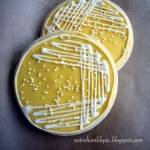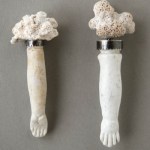biology
tags: Corn: The Dynamic Genome, corn, agriculture, genomics, food science, technology, streaming video
This is a beautifully written and produced science video about corn: where it came from, what it originally looked like, the technology we are using to learn the functions of individual corn genes, and future directions for research into corn genetics.
Plant genome research is already revolutionizing the field of biology. Currently, scientists are unlocking the secrets of some of the most important plants in our lives, including corn, cotton and potatoes. Secrets of Plant Genomes: Revealed…
tags: How It's Made: Bread, baking, agriculture, chemistry, food science, technology, streaming video
This interesting video shows how bread is made in large, mechanized factories: from mixing the ingredients to shipping it out for consumption.
tags: education, public outreach, SciCafe, science cafe, AMNH, American Museum of Natural History, NYC, streaming video
Who: Ichthyologist Melanie Stiassny
What: free public presentation, "Mysteries of the Congo: Exploring the World's Deepest River"
When: 700pm, Wednesday, 6 January 2010
Where: Gottesman Hall of Planet Earth, American Museum of Natural History, Enter at the 81st Street (Rose Center) [directions and maps]
Cost: free, and there is a cash bar (must be 21+ with ID)
What strange new species lurk beneath? Join Museum Curator Melanie Stiassny, an ichthyologist who has been…
The caves in the Dordogne department in southwest France are most famous for paleolithic cave paintings at Lascaux (the Dordogne is also famous for the being the home of microdot, whose blog The Brain Police is one of my daily reads). Now it has yet another claim to fame: the discovery of the first bat outside of the northeastern United States with White Nose Syndrome (WNS) Fungus (Geomyces destructans):
Biologists are struggling to understand a recent emerging infectious disease, white-nose syndrome (WNS), which potentially threatens >20% of all mammalian diversity (bats). WNS is a deadly…
If you've ever worked in a bio lab, you know what I mean: these look too real!
Yes, I know Pharyngula and BoingBoing already got to them early this month, while I was in the middle of finals, but I just had to blog them anyway. They're too bioE. Besides, you can use them as a New Year's diet aid.
tags: The Nature of Cell Science, cell biology, microscopy, research, science, music, Venetian Snares, Szamár Madár, field work, Dirk Pacholsky, streaming video
Cell biologist, Dirk Pacholsky, created this video. He writes; "Certainly it´s irony in the title, because these images never made it to publication status. Sitting over the microscope, whilst listening to music the idea popped up to combine microscopic imagery with electronic music. The Scientist will certainly see more than a carpenter, but both might enjoy the beauty. Concerning the accompanying music, it is Venetian Snares (oh…
The Swedish Skeptic Society's annual awards for 2009 were announced yesterday.
Professor emeritus of ecological zoology Staffan Ulfstrand receives the Enlightener of the Year award,
"... for his engrossing and pedagogical books about evolution [such as Savannah Lives: Animal Life and the Human Evolution of Africa] and his many pop-sci talks, particularly during the double Darwin jubilee of 2009. Staffan Ulfstrand frequently appears on nature shows, in Q&A columns and in debates about biology and behaviour. He has also frequently explained evolution in a pedagogical manner when it has…
tags: Fencing Flamingos, ornithology, ecology, endangered species, food webs, research, field work, Marita Davison, Jennifer Moslemi, Jamie Herring, streaming video
"Fencing Flamingos" follows the work of Marita Davison, a PhD student in Ecology and Evolutionary Biology at Cornell University, and her collaborator Jennifer Moslemi as they study flamingos in the rugged high-Andes of Bolivia. The harsh conditions made it challenging to make the video, Davison says, but it's been worth it. "We've had more people see the video than I'll ever have reading a journal article that I write." The video…
scarobeus cornepleura
Mauricio Ortiz
The technically gifted Mauricio Ortiz is originally from Costa Rica, but now lives in London, where his artistic star is on the rise. His octo-beetle, above, was recently selected to appear in a deck of playing cards as part of a high-profile British charity fundraiser, alongside a card by British bad boy Damien Hirst.
The octo-beetle is one of a number of painstaking drawings in the style of scientific illustrations, and inspired by Wunderkammern, the "wonder cabinets" of the Renaissance. Rather than starting with completely unfamiliar wonders, though,…
The natural home for influenza viruses is aquatic waterfowl, including ducks and geese (anseriformes). So I've read a fair amount about swabbing the claocae (rectums) of these animals as part of avian influenza surveillance. Recently it has been suggested that avian influenza is actually a sexually transmitted disease, so the question of anseriform sex is now on the agenda. It's not just consensual sex. It turns out that male ducks and geese haven't heard that rape (aka forced copulation) is frowned up in civilized society and, unusual among birds, they go in for it in a big way. Big in lots…
tags: Syngonanthus chrysanthus 'Mikado', plants, horticulture, Expat Life, Frankfurt through my eye, photography, image of the day
Syngonanthus chrysanthus 'Mikado' cultivar.
Image: GrrlScientist, 26 December 2009 [
Syngonanthus chrysanthus 'Mikado' cultivar.
Image: GrrlScientist, 26 December 2009 [larger view].
This plant has dozens of tiny unscented flowers on the ends of stalks that are up to 35 centimeters tall. These flowers resemble shiny gold balls and when opened, have tiny, paper-thin cream color petals. Its long, narrow and slightly fuzzy leaves closely resemble grass. These…
Yeah, sure that plush Borrelia burgdorferi (the bacterium that causes Lyme disease) is playfully cuddling the plush penicillin now. But can their friendship last?
(Actually, in light of the fact that penicillin inhibits transpeptidase in gram-positive bacrteria, and of the fact that Borrelia burgdorferi is gram-negative, maybe those two love-sick kids can make it work.)
Uttered by Dr. Free-Ride's better half upon extracting the plush penicillin from the Christmas stocking: "I'm going to have to keep that away from my syphilis!"
tags: education, public outreach, SciCafe, science cafe, AMNH, American Museum of Natural History, NYC, streaming video
Who: Ichthyologist Melanie Stiassny
What: free public presentation, "Mysteries of the Congo: Exploring the World's Deepest River"
When: 700pm, Wednesday, 6 January 2010
Where: Gottesman Hall of Planet Earth, American Museum of Natural History, Enter at the 81st Street (Rose Center) [directions and maps]
Cost: free, and there is a cash bar (must be 21+ with ID)
What strange new species lurk beneath? Join Museum Curator Melanie Stiassny, an ichthyologist who has been…
The new piece by Natalie Angier at the New York Times may make things a little more ticklish for people who pick their food on the basis of the characteristics it has or lacks as an organism:
[B]efore we cede the entire moral penthouse to "committed vegetarians" and "strong ethical vegans," we might consider that plants no more aspire to being stir-fried in a wok than a hog aspires to being peppercorn-studded in my Christmas clay pot. This is not meant as a trite argument or a chuckled aside. Plants are lively and seek to keep it that way. The more that scientists learn about the complexity…
Photo: Jana Asenbrennerova / The Chronicle
SFGate has a great interview with Raven Hanna of madewithmolecules! I love Raven's stuff an am thrilled to see her getting recognition.
"Insectopedia"
Kiff Slemmons
Self-taught metal artist Kiff Slemmons' classic series "Insectopedia" is a collection of metal pins fusing insects with typography. She's also known for working with found objects like shells, stones and bones, as in the following pieces from her recent show with Kay Sekimachi at Velvet da Vinci in NYC:
"Corallary 2 & 3" Brooches
Kiff Slemmons
"Atoll" Necklace
Kiff Slemmons
View a complete set of photos from the Velvet da Vinci show here.
More:
Article on Kiff Slemmons at Ornament Magazine
tags: education, public outreach, SciCafe, science cafe, AMNH, American Museum of Natural History, NYC, streaming video
Since the holidays are a busy time, I am notifying you of NYC's upcoming SciCafe a little early so you can be sure to add it to your calenders!
Who: Ichthyologist Melanie Stiassny
What: free public presentation, "Mysteries of the Congo: Exploring the World's Deepest River"
When: 700pm, Wednesday, 6 January 2010
Where: Gottesman Hall of Planet Earth, American Museum of Natural History, Enter at the 81st Street (Rose Center) [directions and maps]
Cost: free, and there is a…
Found on ebay: "Peter Parley's Tales of Animals, containing descriptions of three hundred quadrupeds, birds, fishes, reptiles, and insects. With numerous engravings."
Note to the Critics.
This book is almost wholly a mere compilation; free use has been made, in preparing it, of the Library of Entertaining Knowledge, the Family Library, Wilson's Ornithology, Gedman's Natural History of North America, &c. I make this confession to you; but if I chose to keep this matter a secret from my readers generally, and leave them to infer that my various knowledge is original, this is either their…
Image: Jesus! vs. Darwin! by The Searcher
It's a tired old routine, yet time and again the same argument is taken off the shelf, dusted, buffed and then presented with a sly smile as if it were something new. Evolution, it's asserted, is only progressive and builds on earlier adaptations in its march forward through natural history. Therefore, if there is any evidence that a species adapted "backwards" it must mean that natural selection is flawed. However, the fallacy in this argument is that natural selection has nothing to do with progress, it's merely one of the mechanisms by which…
The National Library of Medicine's "Turning the Pages" gallery lets you turn the virtual pages of classic science/medicine manuscripts. Check out Hieronymus Brunschwig's Liber de Arte Distillandi de Compositis (1512):
Note that the NLM's copy is hand-colored; uncolored copies also exist, such as this copy at ECHO. Comparison with the images of the ECHO copy show that NLM has elided the boring, text-only pages from their animation.
I'm not usually a big fan of animations that try to replicate the tactile experience of books, but given that you aren't usually allowed to touch manuscripts of…




